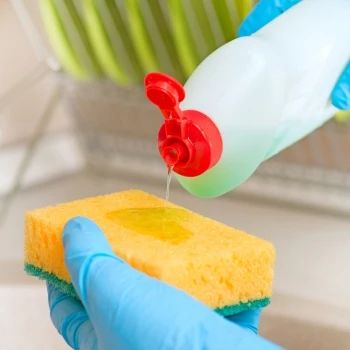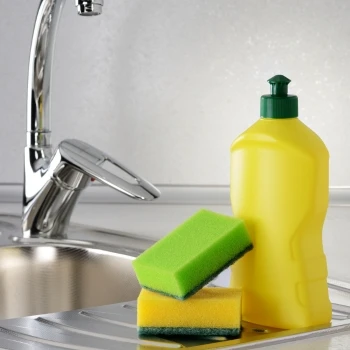
Dishwashing liquid, known as dish soap, is a staple in kitchens worldwide. This essential cleaning agent is designed to tackle grease, oil spills, grime, and food residues on dishes ensuring they are hygienically clean and ready for the next meal. But what exactly goes into dishwashing liquid, and how does it work?
In this article, we’ll delve into the composition, uses, and benefits of dish soaps, providing you with a comprehensive understanding of this everyday household product.
Quick Summary
• Dishwashing liquid is a crucial cleaning agent formulated to remove dirt, grease, and germs when washing dishes, emphasizing hygiene and safety beyond mere cleanliness.
• Key ingredients in dishwashing liquid detergent include surfactants for breaking down grease, enzymes for targeting specific food residues, and fragrances for a pleasant scent.
• There is a variety of dish liquids available to meet different needs, including eco-friendly, anti-bacterial, and heavy-duty options.
What is Dishwashing Liquid

Dishwashing liquid, also known as dish soap, dish detergent, dishwashing soap, or dishwashing detergent, is a specially formulated cleaning agent designed to tackle the challenging task of removing dirt, grease, and germs from our dishes as we wash dirty dishes.
Liquid detergent is a crucial tool in maintaining proper hygiene in our homes, effectively eliminating harmful bacteria and preventing the spread of foodborne illnesses. The scientific formulation of dish soaps caters to specific purposes, whether it’s cutting through tough grease or being gentle on sensitive skin.
Key Ingredients in Dishwashing Liquids
The effectiveness of dish soaps lies in their carefully balanced blend of ingredients, each serving a specific purpose in the cleaning process.
Surfactants in Dish Soaps
Surfactants, also known as surface-active agents, are essential components in dishwashing liquids. They work by reducing the surface tension of water to help break up and wash away grease and grime.
Dishwashing liquids typically contain a mix of different types of surfactants to optimize cleaning performance. Some common surfactants found in dishwashing liquids include [1]:
• Sodium Lauryl Sulfate (SLS)
• Sodium Laureth Sulfate (SLES)
• Cocamidopropyl Betaine
• Decyl Glucoside
Anionic surfactants, such as SLS and SLES, are particularly effective at binding and removing positively charged dirt and grease. These surfactants, often combined with sodium gluconate, are known for their strong foaming and emulsifying abilities, creating the satisfying suds we associate with clean dishes.
Nonionic surfactants like Fatty Alcohol Polyoxyethylene Ether (AEO-9), sodium coco sulfate, and sodium hydroxide are gentler on the skin and are often included in formulations for sensitive skin. Amphoteric surfactants, such as Cocamidopropyl Betaine, enhance the overall cleaning and foaming properties of the dishwasher detergent while being mild on the hands.
Enzymes for Enhanced Cleaning Power

While surfactants form the foundation of dishwashing liquids, enzymes provide an extra boost of cleaning power, particularly when it comes to tackling stubborn food residues. These biological catalysts are specialized proteins that target specific types of food stains, breaking them down into smaller, more manageable particles that can be easily washed away.
The most common enzymes found in dishwashing liquids are:
• Proteases: They are particularly effective at breaking down protein-based stains, such as those from eggs, meat, or dairy products.
• Amylases: They target starch molecules, making them ideal for dealing with residues from pasta, potatoes, or other carbohydrate-rich foods.
• Lipases: These specialize in breaking down fats and oils, helping to eliminate greasy residues that might be resistant to surfactants alone.
By incorporating these enzymes into their formulations, dishwashing detergent manufacturers can create products that offer superior cleaning performance across a wide range of food stains and residues.
Fragrances, Dyes, and Preservatives
While the primary focus of dishwashing liquids is their cleaning efficacy, manufacturers also consider the overall user experience when formulating their products. This is where fragrances and dyes come into play.
Fragrances are added to provide a pleasant scent, making the dishwashing process more enjoyable and leaving a fresh aroma in your kitchen.
Similarly, dyes are incorporated into dishwashing liquids purely for aesthetic reasons. The vibrant colors we often see in these products are designed to make them visually appealing and can sometimes be used to differentiate between different variants or scents within a product line.
Conversely, preservatives serve a significant functional purpose. These additives help prevent microbial growth and extend the shelf life of the product, ensuring that your dishwashing liquid remains effective and safe to use over time.
Types of Dishwashing Liquids

As consumers become more conscious of their environmental impact and personal health, the market for dishwashing liquids has diversified to meet these evolving needs.
• Standard Dishwashing Liquid: Common and effective for everyday grease and grime, these liquids contain surfactants to leave dishes sparkling clean.
• Eco-Friendly Dishwashing Liquid: Made with biodegradable, plant-based ingredients, these are gentler on the environment without sacrificing cleaning power.
• Antibacterial Dishwashing Liquid: Formulated with antimicrobial agents to kill bacteria and germs, offering extra protection. Useful during flu seasons or when handling raw meat.
• Fragrance-Free Dishwashing Liquid: Perfect for individuals with sensitive skin or allergies, these liquids provide gentle cleaning without added scents. Ensures dishes are free of lingering smells.
• Dishwashing Liquid with Added Moisturizers: Contains moisturizers like aloe vera to protect and nourish hands during dishwashing. Great for frequent hand washers wanting to maintain soft skin.
• Heavy-Duty Dishwashing Liquid: Designed for tough, baked-on grease and stubborn food residues with stronger surfactants. Ideal for pots, pans, and heavy food build-up.
• Specialty Dishwashing Liquids: Tailored for specific needs like hard water areas or septic systems, preventing mineral build-up and ensuring septic safety. Great for unique cleaning challenges.
How Dishwashing Liquids Work

The fascinating science and clever chemistry behind how dishwashing liquids clean our dishes is intriguing.
At the heart of their cleaning action is the ability to reduce water’s surface tension. Surface tension is what causes water to bead up on surfaces, and it’s one of the reasons why water alone isn’t very effective at cleaning. Dishwashing liquids contain surfactants that break this tension, allowing water to spread out and penetrate even the smallest crevices on dish surfaces.
When you apply dishwashing liquid to your sponge or directly onto dishes, the surfactant molecules in the liquid begin to work immediately. These molecules have a unique structure with a hydrophilic (water-loving) head and a hydrophobic (water-repelling) tail. The hydrophobic tails are attracted to grease and oil, while the hydrophilic heads remain in the water.
As you scrub your dishes, the molecular structure of the dishwashing liquid facilitates the removal of oil and cut grease from the surface. The surfactants surround and encapsulate these particles, forming microscopic structures called micelles.
When you rinse your dishes, these micelles, along with the trapped dirt and grease, are easily washed away by water. This process explains why dishes washed with dishwashing liquid come out clean and grease-free, whereas washing with water and bar soap alone often leaves residues behind.
Additional Uses for Dish Soap
Although primarily designed for cleaning dishes, the versatility of dishwashing liquid extends well beyond the confines of the kitchen sink.
It’s also excellent for:
• Cleaning kitchen cabinets and countertops when mixed with warm water.
• Removing soap scum from bathtubs or shower walls when mixed with cornstarch and vinegar.
• Cleaning paint brushes, hairbrushes, and combs when mixed with cornstarch and vinegar.
• Gardeners can benefit from a mixture of dish soap and water to combat plant pests like aphids.
• For those battling weeds, a concoction of dish soap, vinegar, and salt can serve as a homemade weed killer.
• Pet owners will be pleased to know that dish soap can be used as a gentle, flea-fighting shampoo for their furry friends.
• It’s particularly effective at cleaning greasy fur, making it a handy solution for pets who’ve had unfortunate encounters with automotive fluids or other oily substances.
Choosing the Right Dishwashing Liquid

Here are five factors you should consider when selecting the ideal dishwashing liquid to meet your needs.
1. Ingredients: Opt for eco-friendly, biodegradable formulas that are gentle on the environment and do not cause any skin irritation.
2. Effectiveness: When you wash dishes you should use a dishwashing liquid that effectively cuts through grease and leaves dishes spotless.
3. Scent: Choose a fragrance that you enjoy, whether it’s citrus, floral, or unscented for sensitive noses.
4. Cost: Balance between affordability and quality; often, mid-range options provide the best value.
5. Packaging: Consider products with recyclable or refillable packaging to reduce environmental impact.
FAQs
Can I Use Dishwashing Liquid in My Dishwashing Machine?
No, using regular dishwashing liquid in a dishwashing machine is not recommended. Dishwashing detergent can create excessive suds, potentially causing damage to the dishwasher and leaving a soapy residue on the dishes.
How Much Dish Detergent Should I Use Per Wash?
You should use a teaspoon of dish detergent for a sink full of dishes to avoid excessive suds and make rinsing easier. When you wash dishes and encounter tough grease, apply the soap directly to the dish or sponge rather than adding more to the sink.
Can Dishwashing Liquid Expire?
Yes, dishwashing liquid can degrade over time, especially if not stored properly, and it remains effective for 12-18 months after opening. Always store it in a cool, dry place to ensure its longevity.
Did you enjoy this article? See Wynbert’s homepage for more information on how to keep your household pristine clean.
Reference:
